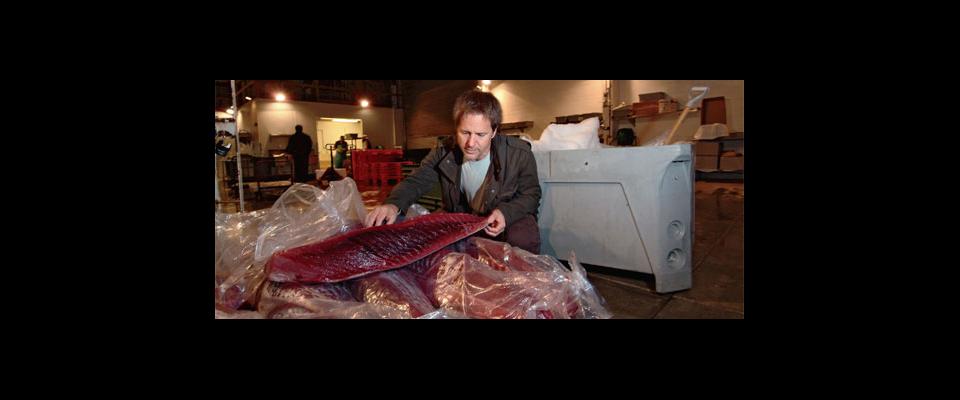Maverick chef Eric Gower throws kitchen convention to the wind.
Eric Gower’s kitchen is small—cramped, even—and bears little resemblance to the chrome culinary laboratories made famous by the Food Network. Mismatched pots and skillets hang over his vintage Wedgewood stove, its top shelf crowded with brightly colored salts. The cartoon-bedecked refrigerator door can’t be opened without brushing the cook’s rear end. Jars of spices and other staples line the walls, and a bag of dried tangerines winks brilliantly from a tiny pantry.
This may seem an unorthodox place to produce breathtaking food, but that’s just what Gower does. He has prepared thousands of meals in this space, refining not just individual recipes, but a food philosophy that he’s hoping to popularize with the May publication of his third cookbook, The Breakaway Cook.
The signature of a breakaway cook is simple, quick dishes whose scrumptiousness depends on fresh produce and intense flavors gathered from the aisles of Asian, Indian, and Latin markets. Breakaway cooks use coffee grinders to mix sea salt with just about anything (green tea, lavender, smoked paprika) to create new, surprising accents. They experiment with habanero, lemongrass, miso, pomegranate molasses, and other “global flavor blasts,” as Gower terms them. And perhaps most important, they ignore the dictates of tradition.
“All I care about is how something tastes and whether it’s any good. I don’t care about the rules,” says Gower, with a grin. “I disregard all the rules.”
Gower, 45, grew up in a meat-and-potatoes Pennsylvania family—”my job at dinner was to select which can to open,” he says—and first moved west to study modern Japanese literature at Berkeley. After graduating in 1987, he moved west again—this time to Japan, which, as a year of post-college exploration stretched into 15 years of expatriate life, eventually became home.
He worked as an editor for the Japanese Prime Minister, a job he now does on a contract basis from his San Francisco home. “I lived in a village farmhouse with holes in the roof,” he remembers. “It snowed inside the house and there were a couple of mushrooms growing in the corners.” In his tiny kitchen, and with very little in the way of cookware, he happily ignored the principles that govern traditional Japanese cuisine. “I’d go to markets and buy everything I saw. I didn’t worry about what I was supposed to do.” Rather than slicing shiitakes into soup, he ground them into a powder that became a pesto base. Instead of serving udon noodles steeped in a “canonical” broth, he tossed them with citrus, ginger, and mint.
“People got kind of upset,” Gower recalls. In a country where food preparation is governed by centuries of ritual and practice, Eric’s Kitchen, his first cookbook aimed at a Japanese audience, was generally well received but prompted complaint from diehard traditionalists. At a book-signing, friends had to physically shield Gower from a man livid over his liberal take on food. But skeptics who ventured to taste the unfamiliar creations rapidly became “almost evangelical” converts to the breakaway style.
When he returned to San Francisco in 2002, Gower found the Bay Area food scene transformed by a plethora of farmers’ markets featuring local, organic produce. Those markets, coupled with a plethora of ethnic food shops, have made the Bay Area an ideal American landing spot for breakaway cooking.
“I’m kind of standing in the middle of those two communities—the Alice Waters community of sustainable agriculture, and the immigrant community with their brilliant food.”
Now, Gower seeks recipe inspiration by hopping on his bike to explore San Francisco’s ethnic markets. He has come to love an Indian shop on 16th and Valencia (it has excellent homemade cardamom ice cream, he notes) and the Middle Eastern markets in The Avenues. These mostly unheralded food-shopping opportunities provide him with exotic and unfamiliar ingredients, each of which becomes the inspiration for a new dish.
Other creations—such as eggs baked with maple syrup, chives, and rhubarb—are happy accidents, he says, born not from bold shopping expeditions but from “a snarling stomach and very few things in the fridge.”
Fearlessness is essential to breakaway cooking, says Gower, and his goal is to help home cooks become less intimidated by experimentation. Although his recipes are explicit and easy to follow, he sees his books as guides, rather than strict directions, for creating yummy, unconventional meals. “You have to trust your palate. Trust it, taste, and make adjustments as you go. That’s what chefs do.”
Failures are an inevitable consequence of culinary risk-taking, but Gower says that dinner is rarely irretrievable if you use a few stellar ingredients and pay attention to flavors as they develop. “I specialize in bringing something back that’s not working,” he laughs. “Salt usually helps.”
For presentation, Gower borrows from the Japanese tradition, serving meals on handmade ceramic dishes that are as asymmetrical and mismatched as they are handsome. “Beauty matters when you’re eating. If you put a little bit of care into your table, it brings another kind of aesthetic experience to eating in a way you can’t do with paper plates and plastic cheap-o crap.”
He is by no means the only chef singing the praises of farmers’ markets and exotic flavors—what sets Gower apart is his contagious conviction that delicious and unorthodox food is an achievement within reach of the most inexperienced cooks. His simple recipes and his decidedly average knife collection are enough to make even the least-discriminating eater confident about experimentation.
“I love eggs,” says the original breakaway cook, by way of example. He prefers them poached, topped with freshly ground pepper and a dollop of green tea salt. “There’s something about the marriage of the yolk and the tea that’s kind of celestial,” he promises. Most people cannot say such things without eliciting a certain amount of eye-rolling, especially outside of California. But Eric Gower speaks with a combination of ardor and sincerity that conquers cynicism. People within earshot don’t just listen to Gower. They believe him.
Emma Brown is a California magazine intern. Eric Gower’s third cookbook, The Breakaway Cook, published by Morrow Cookbooks, is available now.
From the May June 2007 New Food and Farming issue of California.





















